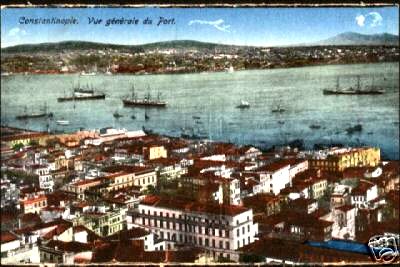IN CONSTANTINOPLE
by James Burney

| ROMANIAN POST OFFICE
IN CONSTANTINOPLE by James Burney |
 |
|
1896 In
1896 the Romanian Post Office decided to open an office in The
stamps issued for use in the Romanian post office in The
unoverprinted stamps come in three different perforation varieties,
P13½, P11½ and a compound of P13½ and P11½. In addition to these
perforation varieties there may also exist other varieties caused by the
use of various types of paper, and also watermark varieties on the
original stamps. The stamps were watermarked with "P R", the original
issue in 1893 having a watermark 11mm tall, but in 1895 a second type
measuring 13½ - 14½mm tall was introduced. Unfortunately I do not have
any information on the existence or otherwise of these varieties.
Last
but not least the overprints were done in two colours, black and mauve. The
table below is a basic guide to the stamps.
Unused postal card (violet overprint)
Cancelled to order postal card (violet overprint)
dated 20 April 1896 The
postmark used was a circular date stamp inscribed “POSTA – ROMANA *
COSPOLI”, with the date horizontally across the center of the postmark,
i.e. “21APR896”. Above the top of the cancel there is an ornate design.
The postmark was struck in a dark violet colour. I do
not know if the Romanian Post Office provided a registration service
from this office. In
addition to the above postmark some covers / cards can be found with
additional cancels, or labels, of the Orient Express. Whilst these are
of interest they are essentially transit marks and have no connection to
the Romanian Post Office. |
|
1919 |
|||||||||||||||||||||||||||||||||||
|
After
the end of the First World War the Romanian postal authority decided to
open a post office in Forged
overprints do exist in these issues, but the main identifying trait of
the forgeries is that in the genuine overprints the second "T" in
"CONSTANTINOPOL" has a small gap between the upright and the horizontal
parts of the letter. The
values and perforation varieties are shown in the table below.
The
exact dates that the office opened and closed are unknown. Although the
earliest postmark I have seen is dated ?? August 1919.
Postcard
written and dated 17 January 1919 to
Philatelic cover cancelled 7 September 1919
Philatelic cover cancelled 7 September 1919
Full set of the 1919 overprint on cover cancelled
17 October 1919
Postcard from Cluj to
Genuine stamps on cover with forged postmark in
blue dated 25 July 1919 The
postmark used is a double circular date stamps, outer circle 31.5mm,
inner circle 20.5mm. It is inscribed “POSTES ROUMAINES * Forged
postmarks exist, but are generally easily identified, most have the date
in the postmark at right angles to the genuine cancels, the date format
is also different, “ During
the 1919 to 1922/3 period the Romanian office provided a registration
service, and used labels to indicate that the item was registered. Prior
to the official opening it is believed that the office of Romanian
Steamship Company unofficially accepted items for posting, however there
were no postal marking applied. I have one example of a postcard written
in |